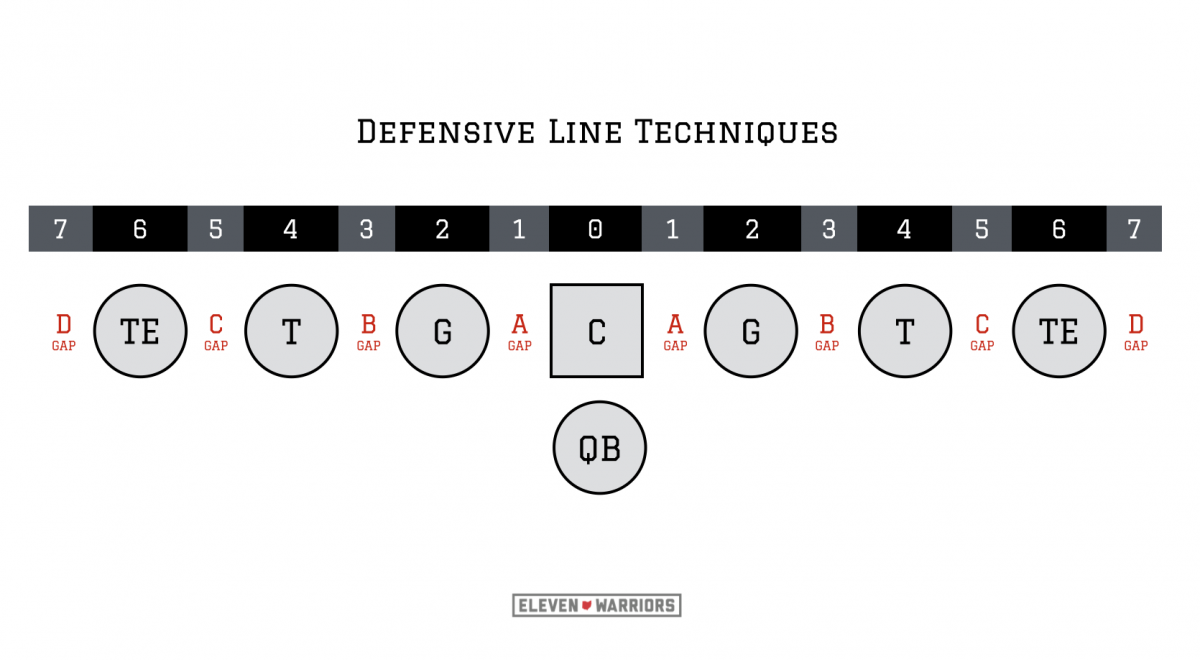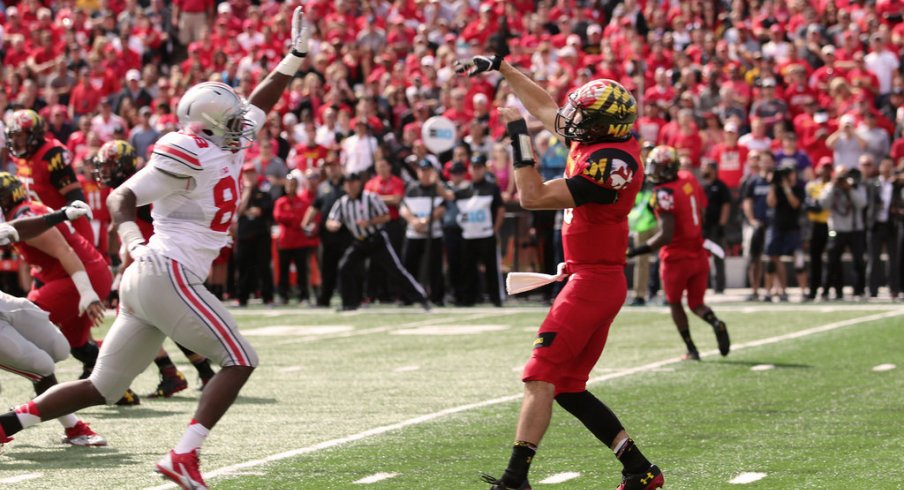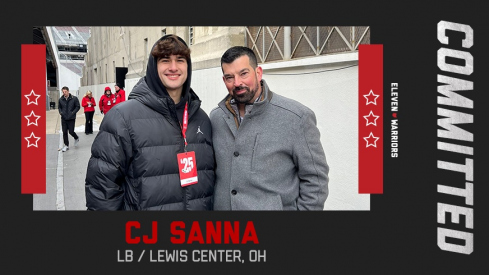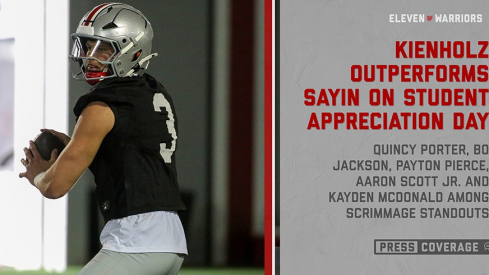A reeling 2-3 Maryland team rolls into Columbus fresh off an ugly 28-0 home loss to Michigan.
Serious questions remain about a struggling offense that managed 105 yards total yards last week, leading Head Coach Randy Edsall to name not one, not two, but three co-starters at the quarterback spot leading into the Ohio State game.
Quarterback Roulette
Three Terrapin signal callers have received significant playing time this season, including Redshirt Junior Perry Hills (52.9% completion rate/4 TDs/2 INTs), redshirt junior Caleb Rowe (44.0% completion rate/4 TDs/12 INTs), and Oklahoma State transfer Daxx Garman (33.3% completion rate/1 TD/1 INT).
Hills started the first two games, but was replaced late in a 48-27 loss to Bowling Green by Rowe, who has started the Terps' last three games. The game of musical chairs continued as Garman replaced Rowe in losses to both West Virginia and Michigan.
An Offensive Offense
The offensive statistics are grim. The Terrapins are currently ranked 110th in the nation in scoring at 17 point per game. The three quarterbacks have combined to complete only 45.3% of their passes for 169.8 yards per game, while throwing 15 interceptions. Giving up only 150 passing yard per game, the Silver Bullet secondary should have a clear advantage when the ball goes in the air.
While Maryland lacks a true playmaker in the passing game they do spread the ball around using the run. Three running backs average at least six carries-per-game, with Senior Brandon Ross (#45) leading the group with two touchdowns and 80 yards-per-game, averaging almost six yards per attempt.
Because of inconsistent play in the passing game, Maryland Redshirt Junior WR Levern Jacobs (#8) leads the team with 18 receptions (3.6 per game) and two touchdowns through five games. The Terps are excited about developing Freshmen tight end Avery Edwards (#82) though, who has caught nine passes for two touchdowns over the last four games. As the Terrapins look for an offensive playmaker to compliment Ross on Saturday; can the true freshmen continue to develop?
A Freshman Shall Lead Them?
Maryland primarily runs a spread-based, shotgun “check-with-me” offense that rarely huddles. The unit will often utilize “11” personnel (1 RB and 1 TE) to put the 6’4 234 pound Edwards on the field.
Edwards possesses the physical skill set to line up in multiple formations. The offensive staff will utilize his size and speed by aligning him as the #3 WR in trips sets, while also taking advantage of the former high school defensive end’s physicality by placing him in a three-point-stance on the LOS (line of scrimmage). The Terps hope his ability to create mismatches against LBs and DBs will open up a stagnant offense and provide a much needed playmaker for Maryland’s struggling QBs.


The young TE has the strength, size, and athleticism to make explosive plays in the passing game. Against South Florida Maryland came out in a "Double Tight" formation featuring one RB and two TEs, with Edwards aligned to the passing strength (There are five eligible receivers on the field; the side with three is referred to as the "strength" of the formation). Offensive Coordinator Mike Locksley schemed to isolate his young tight end against a safety or linebacker on a seam route, where he could use his size to box out the defender.
Notice how Edwards bends his route into the middle of the field to create a throwing window for his QB. He shows great concentration to reach over the LB and pluck the ball out of the air using his hands.

Later in the game Edwards took advantage of poor eye discipline by the strong safety as the #3 WR (Receivers are counted outside-to-in) in a Trips set.

Maryland dialed up a well-designed PA Now Screen by the #1 WR. Pay attention to how the #1 WR sells the screen route and the #2 WR "stalks" the CB. This chicanery is vital to getting the SS's eyes into the backfield, allowing the TE to run by him.

Through the Air
The Maryland passing offense features a variety of quick-game concepts such as screens, hitches, slants and outs.
Like Indiana they will run RPOs (Run-Pass Options), combining IZ with a hitch, slant, or "pop" pass to the backside of the run direction. Focus on the "read man" for this RPO from the 2014 OSU-Maryland matchup, Buckeye LB Raekwon McMillan (#5). Because McMillan crashes hard on to defend the run, the QB make the easy throw to the slot receiver who "fills" the area McMillan has vacated.

Although the offense has yet to connect through the air consistently, they will still throw downfield off vertical concepts and play action. In week 3 against South Florida the offense produced an explosive play off Y-Stick concept (made popular by the Patriots). QB Caleb Rowe alertly recognized man coverage and "peeked" the 9 route to hook up with sophomore Taivon Jacobs for a 71 yard TD.

The Terps' most dangerous WR in the passing game is currently Junior Levern Jacobs, who has the speed and open field vision to turn a short completion into a long TD, just as he did running the man-beating Double Slants concept below.

Jacobs' route tree isn't limited to the 3-step game though, as he beats his defender overtop with a post route. He must continue to challenge defenders downfield if Maryland's passing game is going to get back on track.

The Workhorse
The Terp running game features a variety of concepts including Inside/Tight Zone, Speed Option, and the Counter Trey. Ross has been their most reliable offensive weapon through the 2015 season, averaging 5.8 yards/carry and needing just 12 yards to reach 2,000 career rushing yards.
Ross' first TD of the season came off an Urban Meyer favorite, a variation of the Buck Sweep. His vision, patience to let his blocks develop, and strength to run through an ankle tackle make him a dangerous open field runner.

Against South Florida Ross showed outstanding strength and ability to finish a run on the OSU staple Counter Trey. Notice how his aggressive jab step influences the WILL (#51) to aggressively fill the D-gap away from the play direction, clearing out a defender at the POA.
Ross presses the hole behind the block of his wrapping TE and displays strength to finish the run while taking contact from three defenders on his way to the end zone.

After losing their last two games by an average of 33.5 points, Maryland desperately needs Ross to be an impact player against a Buckeye run defense that has shown vulnerability at times.
Fitting the Run
Stopping the run is truly a squad effort. A single player not playing his run responsibility, or "run fit," can break down the entire unit's integrity. In order to stop Maryland's run game the Silver Bullets must play assignment-based, gap-sound run defense.
The Luke Fickell/Chris Ash 4-3 over defense primarily relies on "1-gapping" to stop the run. Such a defense leaves an individual defender responsible for a single gap, covering all gaps regardless of the offense's formation.

Looking at two plays from last year’s OSU-Maryland matchup will demonstrate how disciplined run fits lead to short plays in the run game, while undisciplined fits lead to gaping holes.
Maryland is aligned in a Trips set with the RB aligned to the right of the defense. Because the offense's Inside/Tight Zone will hit away from the back's alignment and towards the left A-gap, the defense dials up a WILL/NT run stunt.

Interior run stunts can be very effective against Inside/Tight Zone as they alter the "covered/uncovered" rules the OL uses to determine what defender to block post-snap. Stunts and slants also disrupt the C/G double team and eventual climb to the LB, the most important block of a successful Inside Zone play.

The run stunt forces the C to block the WILL, leaving the LG two-on-one against the aggressively slanting DT and MIKE. The "free hitter" allows the defense to tackle the RB for a minimal gain.
Again returning to last year’s matchup, the OSU defense had a serious run fit breakdown on 1st and goal from the two-yard line. The Terps show a Quads set with the RB aligned to the defense's right. Anticipating Inside/Tight Zone, Fickell and Ash again elect to slant the backside away from the RB. If executed correctly, every gap is covered with the MIKE able to fast flow to the ball as a free hitter.

What happens when a single defender doesn't play his gap responsibility?

The WILL and LDE both shoot the C-gap, leaving no B-gap defender. With little effort a college-caliber RB will hit this hole all afternoon.

In the last two weeks, Western Michigan and Indiana have hit the Buckeye on the ground for 169 and 176 yards respectively. With a lack of proven consistent receiving talent from Maryland, will this be the week the Silver Bullet rush defense gets back on track?


